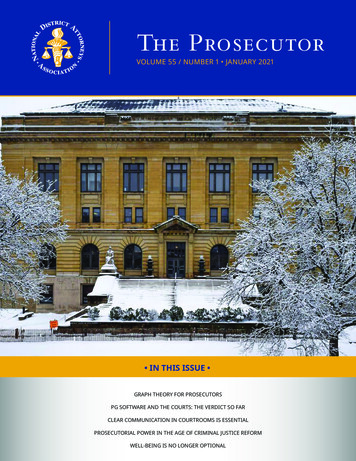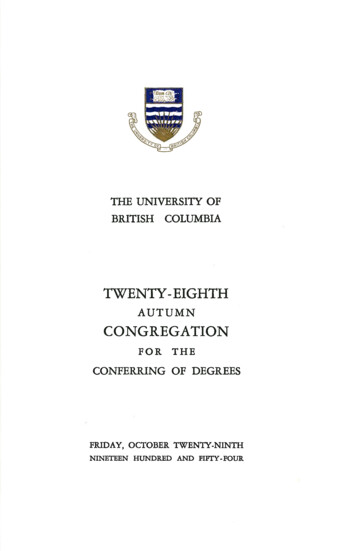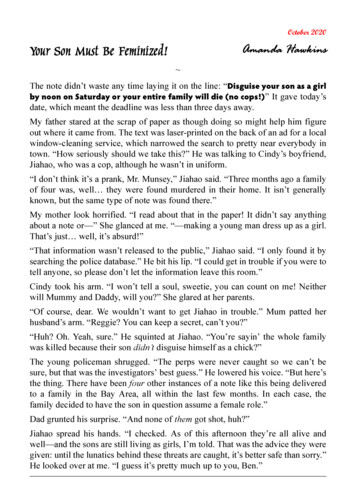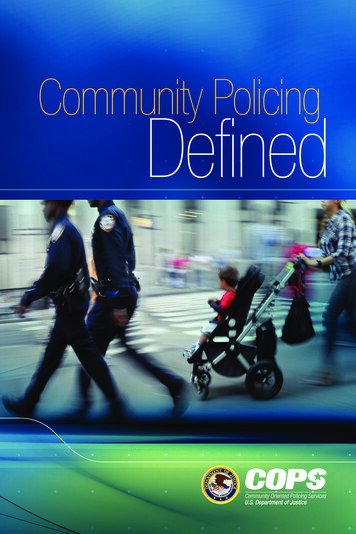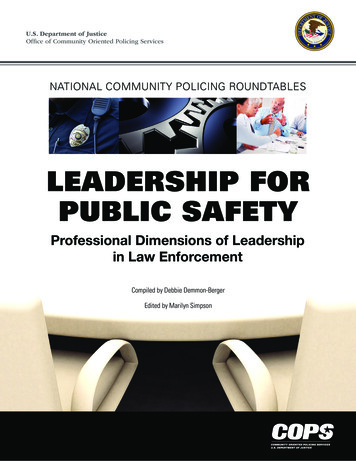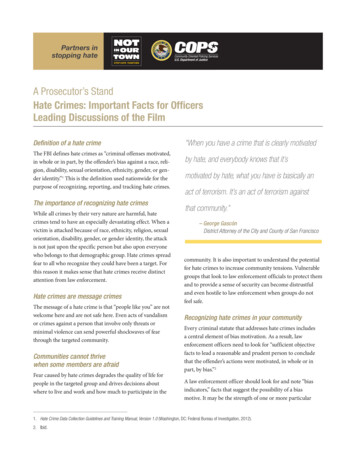
Transcription
Partners instopping hateA Prosecutor’s StandHate Crimes: Important Facts for OfficersLeading Discussions of the FilmDefinition of a hate crimeThe FBI defines hate crimes as “criminal offenses motivated,in whole or in part, by the offender’s bias against a race, religion, disability, sexual orientation, ethnicity, gender, or gender identity.”1 This is the definition used nationwide for thepurpose of recognizing, reporting, and tracking hate crimes.The importance of recognizing hate crimesWhile all crimes by their very nature are harmful, hatecrimes tend to have an especially devastating effect. When avictim is attacked because of race, ethnicity, religion, sexualorientation, disability, gender, or gender identity, the attackis not just upon the specific person but also upon everyonewho belongs to that demographic group. Hate crimes spreadfear to all who recognize they could have been a target. Forthis reason it makes sense that hate crimes receive distinctattention from law enforcement.Hate crimes are message crimesThe message of a hate crime is that “people like you” are notwelcome here and are not safe here. Even acts of vandalismor crimes against a person that involve only threats orminimal violence can send powerful shockwaves of fearthrough the targeted community.Communities cannot thrivewhen some members are afraidFear caused by hate crimes degrades the quality of life forpeople in the targeted group and drives decisions aboutwhere to live and work and how much to participate in the“When you have a crime that is clearly motivatedby hate, and everybody knows that it’smotivated by hate, what you have is basically anact of terrorism. It’s an act of terrorism againstthat community.”– George GascónDistrict Attorney of the City and County of San Franciscocommunity. It is also important to understand the potentialfor hate crimes to increase community tensions. Vulnerablegroups that look to law enforcement officials to protect themand to provide a sense of security can become distrustfuland even hostile to law enforcement when groups do notfeel safe.Recognizing hate crimes in your communityEvery criminal statute that addresses hate crimes includesa central element of bias motivation. As a result, lawenforcement officers need to look for “sufficient objectivefacts to lead a reasonable and prudent person to concludethat the offender’s actions were motivated, in whole or inpart, by bias.”2A law enforcement officer should look for and note “biasindicators,” facts that suggest the possibility of a biasmotive. It may be the strength of one or more particular1. Hate Crime Data Collection Guidelines and Training Manual, Version 1.0 (Washington, DC: Federal Bureau of Investigation, 2012).2. Ibid.
indicators, or the particular combination of indicators, thatultimately leads to the determination that an event is likelya hate crime.Bias indicators include whether the perpetrator and the victim weremembers of different racial or ethnic groups. Thisalone would probably never be enough to support aconclusion that an event was a hate crime; however,under the right circumstances and coupled with otherindicators, such as a complete and surprising absenceof any other apparent or likely motive for a crime, thisfactor may become weighty;“I remember watching them punch andkick him, and he wasn’t moving. Andthen I just saw him being repeatedly kickedin the face. I mean, I’ve seen fights, butI’ve never seen anything like this.”– Courtroom witnessA Prosecutor’s Stand historical animosity between the two groups; comments, statements, or gestures made by theperpetrator before, during, or after the crime; particular drawings, markings, symbols, or graffitiassociated with the crime. These various forms ofexpression can be direct evidence of a bias motive onthe part of the perpetrator, particularly when they arepresent in the commission of the crime itself.Particular objects can also be bias indicators. Few wouldmistake the significance of a cross burned in a yard (biasindicator 1) and in the yard of an African-American family(bias indicator 2) These indicators “lead a reasonable andprudent person to conclude that the offender’s actions weremotivated, in whole or in part, by bias.” But other objects,less universally associated with hate, might also be keys torecognizing the bias motive in a particular crime.One must be careful not to draw conclusions about biasmotives too quickly or too simply. The analysis shouldalways be done on a case-by-case basis. Statements madeby a perpetrator before, during, or after the incident aresometimes the clearest evidence of the existence of a biasmotive. But a bias motive can sometimes be discerned fromthe evidence even in the absence of such statements or otherclear symbolic evidence. As Victor Hwang notes, “If there’sreally dedicated police work to the case,” it can make thecritical difference.How hate crimes are reportedTwo of the main sources for national hate crime datacollection are the FBI and BJS, but these agencies havedifferent approaches. The BJS National Crime VictimizationSurvey3 (NCVS) is collected from a nationally representativesample of households that are interviewed twice a year aboutcriminal victimization. The instrument collects data onfrequency, characteristics and consequences of rape, sexualassault, assault, theft, motor vehicle theft, and householdburglary. This information is based on nonfatal crimes, andit does not matter whether they were reported to the police.The FBI Uniform Crime Report4 (UCR) Hate CrimeStatistics are reported by law enforcement directly to the FBI.This data provides the number of incidents, victims, andoffenders in hate and bias-related crimes whether the crimeis fully or partially motivated by the bias.The hate crime reporting gapAs Victor Hwang says in the film, “The vast majority ofhate crimes are never reported to the police.” Hate crimesin the United States are seriously underreported andunderdocumented, hindering accurate assessment of theproblem. A recent BJS report found that nearly two-thirdsof hate crimes go unreported to law enforcement.5 Thisis because of the unfortunate belief by many victims that3. “Data Collection: National Crime Victimization Survey (NCVS),” Bureau of Justice Statistics, http://bjs.gov/index.cfm?ty dcdetail&iid 245.4. “Uniform Crime Reports,” Federal Bureau of Investigation, http://www.fbi.gov/about-us/cjis/ucr.5. Meagan Meuchel Wilson, Hate Crime Victimization, 2004–2012: Statistical Tables (Washington, DC: Bureau of Justice Statistics, .pdf.2A Prosecutor’s Stand: Hate Crimes—Important Facts for Officers Leading Discussions of the Film
“Immigrant communities are reluctant to approach law enforcement; they feel like there will be retaliationif they do report incidents to the police. There are frequently language barriers. They may see the hatebut they’re not able to express it in the same words and identify them as hate crimes.”– Victor HwangHate Crimes Prosecutor, San Francisco District Attorney’s Officelaw enforcement will be unable or unwilling to address theproblem. Such a breakdown in trust completely underminesthe ability of law enforcement agents to perform their jobs.It is imperative that law enforcement, prosecutors, andvictim advocates do everything they can to build bridgesof trust in the community to facilitate victim reporting andcooperation. First, it is essential that leadership make it clearthat accurate reporting is a priority for the agency. Trainingis an effective means for accomplishing comprehensivehate crime recognition. Reaching out to victims and towitnesses and encouraging them to report is very important.In addition, intra-agency review of reports can enhance theaccuracy of reporting.Victims of hate crimes need supportOne of the most important features of hate crimes is theheightened vulnerability of the victims, both the individualvictim and the class of victims who belong to the samedemographic group. Victims of hate crimes are oftenmembers of diverse groups already coping with a degree ofdiscrimination and separation to which a hate crime canadd further fear and insecurity. FBI statistics indicate thathate crimes are most often motivated by race, with religionand sexual orientation being the second and third mostcommon motivations.6 Sometimes the targeted groups arein the center of social controversy and conflict, sometimeswith political or religious implications. This is certainly thecase for some victims featured in the documentary. Theseindividuals are naturally going to have a more difficult timereaching out to law enforcement, and they may be distrustfuland have low expectations of prosecutors.Law enforcement, victim advocates, and prosecutors shouldmake special efforts to reach out to hate crime victims. Theirvulnerability is related to the unique trauma they suffer,beyond any physical, mental, or economic injury; it is relatedto the shockwaves of fear that tend to permeate the targetedcommunity in the aftermath.Another characteristic of many hate crimes is the extradegree of violence and cruelty not as common in, forinstance, economic crimes. Even though a bias-motivatedcrime does not require extreme violence to cause fear withina vulnerable community, research has shown that attacksmotivated by bias tend to be more violent than attacks thatarise out of other circumstances. A 2013 BJS report revealedthat while violent non-hate crime victimizations decreasedbetween 2007 and 2011, the percentage of hate crimes thatwere violent victimizations increased.7 For all of thesereasons, the special vulnerability of hate crime victims is afeature to which law enforcement must be especially attentive.It is important to note that understanding and goodcommunity relations do not involve “taking sides” onpolitical controversies that may surround some groups. Thefocus for law enforcement should be on protecting membersof the community, regardless of who they are, and the taskis to pursue a positive working relationship that will make itpossible to do this effectively.Effective law enforcement responseAll hate crimes deserve focused attention and good lawenforcement work. In the film, Victor Hwang repeatedlypoints out how thorough investigative work madethe difference in his cases. The ultimate objectives are6. Ibid.7. Nathan Sandholtz, Lynn Langton, and Michael Planty, Hate Crime Victimization, 2003–2011 (Washington, DC: Bureau of Justice Statistics, A Prosecutor’s Stand: Hate Crimes—Important Facts for Officers Leading Discussions of the Film
preventing crime and enhancing public safety. Keep in mindthat these objectives can be furthered even if catching andprosecuting every offender proves impossible. Vigorousresponse to hate crimes by law enforcement will be noticed and appreciated in the community; sends a message to the perpetrators and would-beperpetrators that hate crimes will not be tolerated; enhances security for the public and helps preventfuture hate crimes.Some jurisdictions have specialized hate crime investigationand prosecution units, but most do not. This does notmean hate crimes should not be taken seriously; they shouldbe successfully investigated and prosecuted wherever theyoccur. Where specialized resources are lacking, it maytake extra diligence on the part of officers and investigators,and experts from outside of the agency may need tobe consulted.The importance of prosecuting hate crimesas hate crimesWhen hate crimes occur, it is important that they berecognized for what they are. This is why crimes motivatedby bias should always be reported as hate crimes and whyprosecution for hate crimes should be pursued whereverpossible. When law enforcement and public officialsrecognize such an act for what it is, and when they name itand treat it as what it is, they acknowledge and validate theexperience of the victim and affirm the status of the victimas a full member of the community.From a legal point of view, the essential feature of a hatecrime is the bias element. As Victor Hwang notes in thefilm, this is “a unique element, which is not found in otherparts of criminal law.” When this element is written into acriminal statute, it can make the crime more complicated toprove, and for this reason, some prosecutors are reluctant tocharge perpetrators with hate crimes. However, a convictionunder such statutes typically comes with harsher penalties.Convictions under these statutes have the added benefit of“It’s hard to tell what a motive is in an individualassault. To do that, it requires a more extensiveinvestigation into the person’s background,who they associate with, what kind of literaturethey’re reading, what websites they’re visiting,the overall motivation for why they’re doing whatthey’re doing.”– Victor HwangHate Crimes Prosecutor, San FranciscoDistrict Attorney’s Officegiving the jury the opportunity to name the crime for whatit is. For this reason, prosecutors should bring hate crimecharges where the evidence and the available statutes makethis possible.8Working with your communityLaw enforcement-community relations are especiallyimportant when it comes to hate crimes. Because victims ofhate crimes are often more vulnerable members of society,they are sometimes reluctant to contact law enforcement andreport that they have been the victim of a crime. However,because law enforcement officials need communitycooperation to effectively carry out their responsibilities,encouraging and achieving this cooperation is an importantpart of their work. Good community relations increase the likelihood that hate crimes will bereported by victims to law enforcement; increase cooperation by witnesses; increase the support for law enforcement officialsas they perform their jobs.8. To understand the details of the criminal statutes related to hate crimes that are applicable in your state, consult your local prosecuting attorney or your state attorneygeneral. Summary material on the hate crime laws of the various states may be found at http://www.adl.org/assets/pdf/combating-hate/state hate crime laws.pdfand http://archive.adl.org/learn/hate crimes laws/map frameset.html.4A Prosecutor’s Stand: Hate Crimes—Important Facts for Officers Leading Discussions of the Film
Law enforcement agencies should be working to establishgood community relations well before they need to rely onthem in a particular criminal investigation. It is importantto consistently maintain and strengthen law enforcementcommunity relations.Because hate crimes grow out of a social climate thatbreeds or abides intolerance, the real key to preventing hatecrime lies not only with law enforcement but also with thelarger community. Members of the community, includingeducators, faith leaders, civic leaders, labor groups, media,and citizens of every age, are in a position to contributemuch more to the prevention of hate crimes than merecooperation with law enforcement. Communities thatactively work to include all groups in community issuesand activities and work to build social bridges to otherwiseisolated groups are less vulnerable to those who would sowfear and division through committing hate crimes. Lawenforcement can play an important role in calling forth thispositive involvement from the community.This project was supported by cooperative agreement number 2012-CK-WX-K021 awarded by the Officeof Community Oriented Policing Services, U.S. Department of Justice.Recommended citation:Sheridan, Paul, Libby McInerny, and Michelle Gahee Kloss. 2015. A Prosecutor’s Stand: Hate Crimes—ImportantFacts for Officers Leading Discussions of the Film. Washington, DC: Office of Community Oriented Policing Services.To read A Prosecutor’s Stand: A Guide for Law Enforcement, please visit http://ric-zai-inc.com/ric.php?page detail&id COPS-P308.U.S. Department of JusticeOffice of Community Oriented Policing Services145 N Street NEWashington, DC 20530To obtain details on COPS Office programs,call the COPS Office Response Center at 800-421-6770.The Working Group /Not In Our TownPO Box 70232Oakland, CA 94612Visit the COPS Office online at www.cops.usdoj.gov.e081414660Published 2015
Fear caused by hate crimes degrades the quality of life for . . "I remember watching them punch and kick him, and he wasn't moving. And . then I just saw him being repeatedly kicked in the face. I mean, I've seen fights, but I've never seen anything like this." - Courtroom witness . A Prosecutor's Stand. How hate crimes are .
